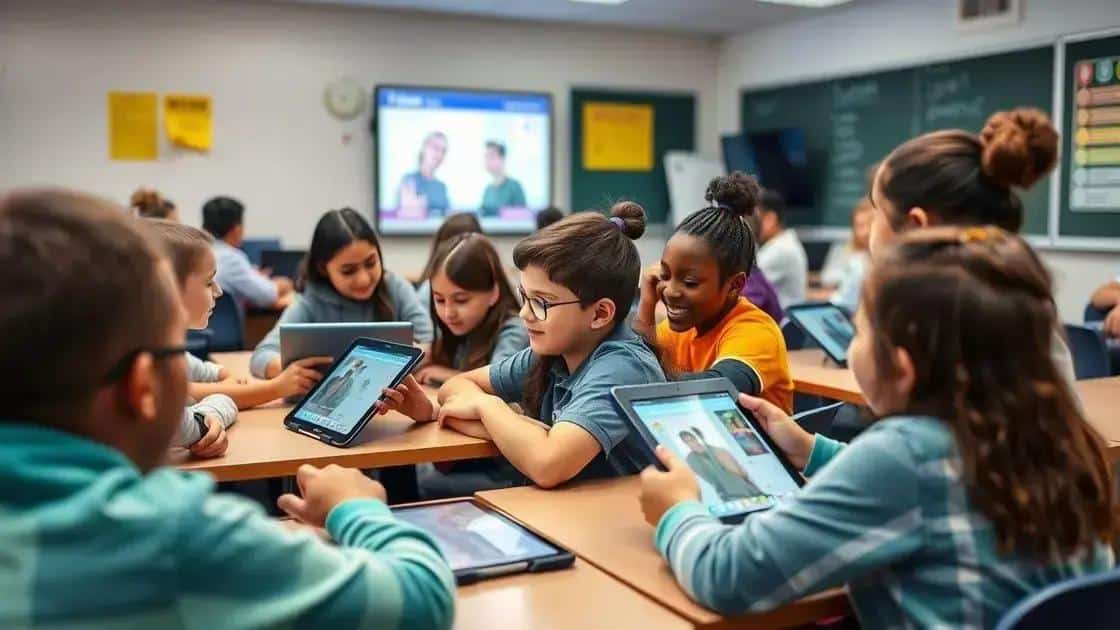Magazine school technology upgrades: are they worth it?

Technology upgrades in schools, including AI and interactive tools, significantly enhance student engagement, personalized learning, and educational outcomes while promoting sustainable practices for a better learning environment.
Magazine school technology upgrades are becoming a hot topic among educators and parents alike. Have you ever wondered how these advancements can reshape learning experiences for students? Let’s dive in and explore what these upgrades truly mean for education.
Assessing current technology in schools
Assessing the current technology in schools is a critical step toward understanding how to improve educational experiences. Many schools have made substantial investments in technology, but how effective are these tools in enhancing learning?
To properly evaluate the existing technology, schools should consider several key aspects. Evaluating current usage helps identify what is working and what isn’t. It’s crucial to look at how often students and teachers utilize the available tools. Are they engaging with the technology effectively, or is it underused?
Factors to Consider in Assessment
When assessing tech in schools, there are several factors to consider:
- Usability: Is the technology user-friendly for both students and teachers?
- Accessibility: Can all students access the technology, regardless of their background?
- Engagement: Does the technology actively engage students in the learning process?
- Outcomes: Are students achieving better results with the technology in place?
Continuous assessment is vital to keep up with the ever-evolving technological landscape. Schools need to regularly gather feedback from teachers and students to understand what works and what doesn’t. This approach allows for quick adjustments and helps ensure that the technology supports learning effectively.
Furthermore, considering the impact of technology on educational outcomes is essential. Studies show that when technology is integrated thoughtfully, it can lead to better student performance and increased interest in subjects. However, if technology is merely superficial, it won’t bring the desired benefits.
Challenges in Technology Assessment
While assessing technology, schools may face challenges such as funding limitations and resistance to change. It’s essential to address these challenges by involving the entire school community in discussions about technology usage. This collaborative approach ensures that everyone has a voice and that the technologies chosen are truly enhancing the educational environment.
In conclusion, assessing current technology in schools is not just about evaluating gadgets or software. It’s about understanding their role in creating an enriching educational experience for all students. By focusing on usability, accessibility, engagement, and outcomes, schools can make informed decisions to improve their technology efforts.
Types of technology upgrades available
Understanding the different types of technology upgrades available for schools is essential for making informed decisions. Schools can enhance their teaching and learning environments by choosing the right tools. Here are some of the most commonly used technologies in educational upgrades.
Digital Devices
Digital devices have become a staple in modern education. These include:
- Laptops: Laptops allow students to access a wealth of information online and complete assignments efficiently.
- Tablets: Tablets are portable and user-friendly, making them ideal for interactive learning.
- Smartphones: Many students use their smartphones as learning tools, accessing educational apps and resources.
Each of these devices offers unique advantages and helps personalize the learning experience. With the right training, teachers can integrate these tools into their curricula and improve lesson delivery.
Interactive Learning Tools
Another important upgrade is the use of interactive learning tools. These tools help increase student engagement and can include:
- Interactive whiteboards: These allow teachers to present lessons dynamically and interactively.
- Student response systems: These enable students to participate actively by responding to questions in real-time.
- Learning management systems (LMS): An LMS helps organize course materials and track student progress effectively.
By implementing interactive learning tools, educators can create a more engaging and stimulating classroom atmosphere. These technologies not only make learning more fun but also facilitate collaboration among students.
In addition to digital devices and interactive tools, schools can also upgrade their networks and infrastructure. This includes ensuring reliable Wi-Fi access, which supports online learning and enables the use of cloud-based applications. Additionally, schools can invest in cybersecurity measures to protect sensitive student information and enhance overall safety.
The impact of technology on student engagement

The impact of technology on student engagement is profound and multifaceted. When integrated effectively into the classroom, technology can inspire and motivate students in unique ways. As students interact with digital tools, their interest in learning often increases significantly.
Enhancing Interactivity
Technology enhances interactivity in learning through various tools and platforms. By using interactive software and applications, students can participate in lessons more actively. This interactivity can lead to:
- Real-time feedback: Students receive immediate responses to their actions, helping them adjust and improve.
- Collaborative learning: Digital tools promote teamwork, as students can work together on projects or tasks.
- Engaging multimedia content: Videos, animations, and games can make complex subjects more accessible and entertaining.
With these interactive methods, students are more likely to stay focused and interested in the lesson material. When they see a connection between what they learn and how it applies to real-world scenarios, their engagement deepens.
Personalized Learning Experiences
Technology allows for personalized learning experiences tailored to individual needs. This customization is crucial in keeping students engaged. For instance, students can progress at their own pace through online courses and educational games. This flexibility fits different learning styles and helps increase motivation.
Moreover, the availability of various online resources enables students to explore topics in depth. They can dive into subjects that interest them, leading to greater satisfaction in their educational journey. When students feel ownership of their learning, they are more likely to actively participate in class discussions and activities.
Additionally, teachers can utilize technology to track student engagement metrics and adapt their teaching strategies. Understanding which strategies resonate with students allows for more effective instruction. Thus, leveraging technology not only enhances engagement but also improves educational outcomes.
Cost-benefit analysis of upgrades
A thorough cost-benefit analysis of upgrades in school technology is vital for making informed decisions. Schools must weigh the costs of new technologies against the potential benefits they bring. This evaluation helps administrators understand which upgrades will provide the most value for students and teachers.
Identifying Costs
When analyzing costs, schools should consider various factors. The initial outlay for purchasing new technology is often the most visible expense. However, there are additional costs that need to be accounted for:
- Training expenses: Educators may require training to utilize new technology effectively, which can incur additional costs.
- Maintenance fees: Regular maintenance is necessary to keep devices and systems functioning properly.
- Software licensing: Some technologies require software licenses that may need annual renewal.
It’s important to create a comprehensive budget that includes all these costs to avoid any surprises down the line.
Assessing Benefits
On the other side of the equation, assessing the benefits of technology upgrades is equally important. Key benefits to consider include:
- Increased engagement: Technology often makes learning more interactive, leading to improved student participation.
- Enhanced learning outcomes: Well-implemented technology can contribute to better academic performance.
- Administrative efficiency: Digital tools can streamline administrative tasks, freeing up teachers to focus on instruction.
Evaluating these benefits helps schools estimate the potential return on investment for the money spent on technology upgrades.
Ultimately, the goal of each upgrade should be to create a better learning environment for students. Successful technology implementations can lead to increased innovation, collaboration, and a more personalized educational experience.
Future trends in school technology
The future trends in school technology are shaping how education is delivered and experienced. As technology continues to advance, schools will need to adapt to remain effective and relevant. Educators and administrators can expect to see a variety of new tools and approaches that enhance learning experiences.
AI and Personalized Learning
One major trend is the increased use of artificial intelligence (AI). AI can analyze student performance and personalize learning paths. This allows students to learn at their own pace and get the help they need more effectively. With AI, teachers can provide tailored feedback and support based on each student’s unique learning style and progress.
Interactive Learning Environments
Another trend is the shift towards more interactive learning environments. Classrooms will become more flexible spaces that encourage collaboration and creativity. Technology such as virtual reality (VR) and augmented reality (AR) will enable immersive learning experiences where students can explore subjects in depth. This hands-on approach fosters a stronger connection to the material they study.
- Flexible classrooms: Furniture and layout will adapt to various teaching methods and group sizes.
- Collaborative tools: Digital platforms that support teamwork will become commonplace.
- Real-world connections: Technology will help link classroom learning to real-life situations, enhancing relevance.
Moreover, the integration of cloud computing will allow students and teachers to access resources and collaborate from anywhere, ensuring that learning can be continuous and not limited to the classroom. As schools embrace these technological advancements, they will create a more dynamic and engaging educational atmosphere.
Sustainability in Technology
Finally, sustainability will play a key role in future technology trends. Schools will seek technology solutions that are environmentally friendly and cost-effective over time. This can include using energy-efficient devices and exploring digital solutions to reduce paper use.
By focusing on sustainability, schools not only save costs but also promote responsible citizenship among students. As technology evolves, staying informed on these trends will be crucial for schools aiming to enhance learning and prepare students for the future.
FAQ – Frequently Asked Questions about Technology Upgrades in Schools
What are the main benefits of technology upgrades in schools?
Technology upgrades enhance student engagement, improve learning outcomes, and streamline administrative tasks, making education more effective.
How can artificial intelligence improve personalized learning?
AI analyzes student performance to tailor lessons according to individual needs, allowing for a customized learning experience.
What role does sustainability play in school technology?
Sustainability involves using eco-friendly devices and practices, helping schools reduce environmental impact while maintaining effective learning environments.
How should schools conduct a cost-benefit analysis of technology investments?
Schools should evaluate both the costs of purchasing and maintaining technology against the potential benefits in student engagement and educational outcomes.






